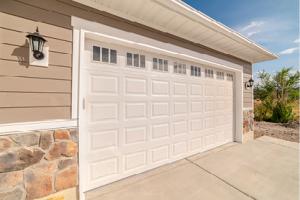What is a wind-rated garage door?

When it comes to storm safety, most homeowners think about fortifying their windows or roof. But many homes have an even larger, and lesser known, vulnerability: their garage door.
A garage door often acts as an entry point for damage during a high-wind event. When they fail, the consequences can be catastrophic, including roof loss, wall collapse and extensive interior damage.
A wind-rated garage door is made using materials and components designed to withstand the intense pressures of high winds and flying debris associated with hurricanes and tornadoes.
Why do I need a wind-rated garage door?
Your garage door covers a large opening—often the largest in your home. If it fails during a storm, wind can rush inside, pressurizing the interior and lifting the roof off like a lid. According to the Insurance Institute for Business & Home Safety (IBHS), homes with intact garage doors are significantly less likely to suffer major structural damage.
How do I know if my garage door is wind-rated?
Check for the wind-rating label. If it’s missing or unreadable, your door may not be rated—or may be too old to meet current standards.
A proper label should include:
- Manufacturer and model number
- Design pressure rating (e.g., +40/-40 psf)
- Wind speed rating and exposure category
- Compliance with ANSI/DASMA 108 or similar standards
Do all areas require wind-rated garage doors?
Not necessarily. Homes in coastal and high-wind zones are more likely to need a wind-rated garage door.
Additionally, each door is assigned a design pressure rating, which can vary based on your home’s location and exposure. For instance, urban areas (Exposure B) face different risks than open zones (Exposure C).
To learn if your current garage door is suitable for your wind zone, refer to FEMA's wind zone map or contact your local building inspector to determine your area’s wind speed requirements.
What do I do if I need a wind-rated garage door?
Choose a door that meets or exceeds your local code. Ensure it’s installed with the correct tracks, struts and fasteners. Consider doors that meet IBHS’s FORTIFIED Home™ standards for added protection and potential insurance benefits.
Are wind-rated garage doors more expensive?
When storms strike, your garage door could be the difference between minor damage and total devastation.
A wind-rated garage door can cost more upfront, but they may save you tens of thousands in storm damage—and could even qualify you for insurance discounts.
Can I retrofit my existing garage door?
Yes. Reinforcement kits are available, but they may not offer the same protection as a fully rated door. In many cases, replacement is the safer and more reliable option.
Don’t wait for the next weather event
Wind-rated garage doors are more than a building code requirement—they’re a critical investment in your home’s safety.
Act today: inspect your garage door, understand your wind zone, and consult a certified installer if you’re unsure. And if you make updates to your garage door, notify your independent insurance agent, as you maybe be eligible for a safety discount on your home insurance policy.
What is a wind-rated garage door?
When it comes to storm safety, most homeowners think about fortifying their windows or roof. But many homes have an even larger, and lesser known, vulnerability: their garage door.
A garage door often acts as an entry point for damage during a high-wind event. When they fail, the consequences can be catastrophic, including roof loss, wall collapse and extensive interior damage.
A wind-rated garage door is made using materials and components designed to withstand the intense pressures of high winds and flying debris associated with hurricanes and tornadoes.
Why do I need a wind-rated garage door?
Your garage door covers a large opening—often the largest in your home. If it fails during a storm, wind can rush inside, pressurizing the interior and lifting the roof off like a lid. According to the Insurance Institute for Business & Home Safety (IBHS), homes with intact garage doors are significantly less likely to suffer major structural damage.
How do I know if my garage door is wind-rated?
Check for the wind-rating label. If it’s missing or unreadable, your door may not be rated—or may be too old to meet current standards.
A proper label should include:
- Manufacturer and model number
- Design pressure rating (e.g., +40/-40 psf)
- Wind speed rating and exposure category
- Compliance with ANSI/DASMA 108 or similar standards
Do all areas require wind-rated garage doors?
Not necessarily. Homes in coastal and high-wind zones are more likely to need a wind-rated garage door.
Additionally, each door is assigned a design pressure rating, which can vary based on your home’s location and exposure. For instance, urban areas (Exposure B) face different risks than open zones (Exposure C).
To learn if your current garage door is suitable for your wind zone, refer to FEMA's wind zone map or contact your local building inspector to determine your area’s wind speed requirements.
What do I do if I need a wind-rated garage door?
Choose a door that meets or exceeds your local code. Ensure it’s installed with the correct tracks, struts and fasteners. Consider doors that meet IBHS’s FORTIFIED Home™ standards for added protection and potential insurance benefits.
Are wind-rated garage doors more expensive?
When storms strike, your garage door could be the difference between minor damage and total devastation.
A wind-rated garage door can cost more upfront, but they may save you tens of thousands in storm damage—and could even qualify you for insurance discounts.
Can I retrofit my existing garage door?
Yes. Reinforcement kits are available, but they may not offer the same protection as a fully rated door. In many cases, replacement is the safer and more reliable option.
Don’t wait for the next weather event
Wind-rated garage doors are more than a building code requirement—they’re a critical investment in your home’s safety.
Act today: inspect your garage door, understand your wind zone, and consult a certified installer if you’re unsure. And if you make updates to your garage door, notify your independent insurance agent, as you maybe be eligible for a safety discount on your home insurance policy.
What is a wind-rated garage door?
When it comes to storm safety, most homeowners think about fortifying their windows or roof. But many homes have an even larger, and lesser known, vulnerability: their garage door.
A garage door often acts as an entry point for damage during a high-wind event. When they fail, the consequences can be catastrophic, including roof loss, wall collapse and extensive interior damage.
A wind-rated garage door is made using materials and components designed to withstand the intense pressures of high winds and flying debris associated with hurricanes and tornadoes.
Why do I need a wind-rated garage door?
Your garage door covers a large opening—often the largest in your home. If it fails during a storm, wind can rush inside, pressurizing the interior and lifting the roof off like a lid. According to the Insurance Institute for Business & Home Safety (IBHS), homes with intact garage doors are significantly less likely to suffer major structural damage.
How do I know if my garage door is wind-rated?
Check for the wind-rating label. If it’s missing or unreadable, your door may not be rated—or may be too old to meet current standards.
A proper label should include:
- Manufacturer and model number
- Design pressure rating (e.g., +40/-40 psf)
- Wind speed rating and exposure category
- Compliance with ANSI/DASMA 108 or similar standards
Do all areas require wind-rated garage doors?
Not necessarily. Homes in coastal and high-wind zones are more likely to need a wind-rated garage door.
Additionally, each door is assigned a design pressure rating, which can vary based on your home’s location and exposure. For instance, urban areas (Exposure B) face different risks than open zones (Exposure C).
To learn if your current garage door is suitable for your wind zone, refer to FEMA's wind zone map or contact your local building inspector to determine your area’s wind speed requirements.
What do I do if I need a wind-rated garage door?
Choose a door that meets or exceeds your local code. Ensure it’s installed with the correct tracks, struts and fasteners. Consider doors that meet IBHS’s FORTIFIED Home™ standards for added protection and potential insurance benefits.
Are wind-rated garage doors more expensive?
When storms strike, your garage door could be the difference between minor damage and total devastation.
A wind-rated garage door can cost more upfront, but they may save you tens of thousands in storm damage—and could even qualify you for insurance discounts.
Can I retrofit my existing garage door?
Yes. Reinforcement kits are available, but they may not offer the same protection as a fully rated door. In many cases, replacement is the safer and more reliable option.
Don’t wait for the next weather event
Wind-rated garage doors are more than a building code requirement—they’re a critical investment in your home’s safety.
Act today: inspect your garage door, understand your wind zone, and consult a certified installer if you’re unsure. And if you make updates to your garage door, notify your independent insurance agent, as you maybe be eligible for a safety discount on your home insurance policy.
What is a wind-rated garage door?
When it comes to storm safety, most homeowners think about fortifying their windows or roof. But many homes have an even larger, and lesser known, vulnerability: their garage door.
A garage door often acts as an entry point for damage during a high-wind event. When they fail, the consequences can be catastrophic, including roof loss, wall collapse and extensive interior damage.
A wind-rated garage door is made using materials and components designed to withstand the intense pressures of high winds and flying debris associated with hurricanes and tornadoes.
Why do I need a wind-rated garage door?
Your garage door covers a large opening—often the largest in your home. If it fails during a storm, wind can rush inside, pressurizing the interior and lifting the roof off like a lid. According to the Insurance Institute for Business & Home Safety (IBHS), homes with intact garage doors are significantly less likely to suffer major structural damage.
How do I know if my garage door is wind-rated?
Check for the wind-rating label. If it’s missing or unreadable, your door may not be rated—or may be too old to meet current standards.
A proper label should include:
- Manufacturer and model number
- Design pressure rating (e.g., +40/-40 psf)
- Wind speed rating and exposure category
- Compliance with ANSI/DASMA 108 or similar standards
Do all areas require wind-rated garage doors?
Not necessarily. Homes in coastal and high-wind zones are more likely to need a wind-rated garage door.
Additionally, each door is assigned a design pressure rating, which can vary based on your home’s location and exposure. For instance, urban areas (Exposure B) face different risks than open zones (Exposure C).
To learn if your current garage door is suitable for your wind zone, refer to FEMA's wind zone map or contact your local building inspector to determine your area’s wind speed requirements.
What do I do if I need a wind-rated garage door?
Choose a door that meets or exceeds your local code. Ensure it’s installed with the correct tracks, struts and fasteners. Consider doors that meet IBHS’s FORTIFIED Home™ standards for added protection and potential insurance benefits.
Are wind-rated garage doors more expensive?
When storms strike, your garage door could be the difference between minor damage and total devastation.
A wind-rated garage door can cost more upfront, but they may save you tens of thousands in storm damage—and could even qualify you for insurance discounts.
Can I retrofit my existing garage door?
Yes. Reinforcement kits are available, but they may not offer the same protection as a fully rated door. In many cases, replacement is the safer and more reliable option.
Don’t wait for the next weather event
Wind-rated garage doors are more than a building code requirement—they’re a critical investment in your home’s safety.
Act today: inspect your garage door, understand your wind zone, and consult a certified installer if you’re unsure. And if you make updates to your garage door, notify your independent insurance agent, as you maybe be eligible for a safety discount on your home insurance policy.





